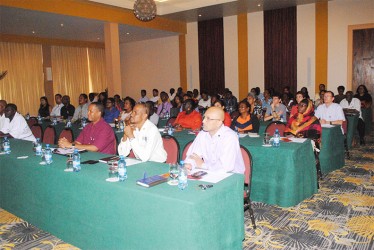Setting aside the role that packaging and labelling play in protecting product identity, they also serve, critically, to help develop product and brand image and enhance visibility in target markets, Beverley Hirst, Managing Director of Jamaican product promotion firm Prism Communications told Stabroek Business during an interview earlier this week.
The head of the Kingston-based firm told this newspaper that companies in the region that neglect to pay attention to raising their packaging and labelling standards to meet the expectations of the lucrative extra-regional markets run the risk of paying a high price in unattained market ambitions.

On Monday, Hirst, along with Craig Bernard, Prism’s Associate Account Director and Ewort Atkinson, its Marketing Strategist, delivered a seminar at the Pegasus Hotel under the theme ‘Positioning Your Product in a Competitive Marketplace’ aimed at helping Guyanese entrepreneurs seeking to secure and/or increase international markets to pay greater attention to the packaging and labelling aspects of product promotion.
Hosted in association with the Caribbean Export Development Agency and endorsed by the Georgetown Chamber of Commerce and Industry (GCCI) and the Guyana Manufacturers and Services Association (GMSA) the forum invited more than 50 participants, including representatives of the local manufacturing sector.
The one-day event served to provide an introduction to a facet of marketing which, these days, is as complex as it is costly though Hirst says that given the proclivity of western consumers to link product quality to presentation, regional producers have no choice but to raise their game. “The choice is between investing in enhanced product presentation [and] getting left behind. One accepts that it is about taking risks but sometimes you need to take the jump,” Hirst says.
Monday’s event attracted some of the more visible operators in the food-processing sector including the Beharry Group of Companies and Sterling Products Ltd. Few of the myriad micro enterprises that have been facing challenges associated with funding high-quality packaging and labelling attended the event, though, a statement sent to this newspaper by the GCCI quoted Prism Communications as saying that its core targets were “small and medium enterprises who believe they have inferior product packaging, looking to make improvements, those without packaging or entrepreneurs interested in packaging for export.”

The rest of the region, not least Guyana, can learn from Jamaica where companies like the highly successful Grace and Lasco have grown used to watching their products hold their own on supermarket shelves in North America. Here in Guyana, even the better-known exporters are only now beginning to fully appreciate the nexus between product presentation and marketing in the manufacturing sector. What is apparent too, is that the local business community lacks the institutional support necessary to drive the popularization of labelling and packaging as a facet of product promotion.
Hirst says Prism is prepared to work with Guyanese firms, through business support organizations to help in better positioning local products to secure enhanced access to international markets.
In the case of Jamaica, Hirst says, manufacturers benefit from the presence of Prism. This week’s exercise in Georgetown was the first time that the firm had ventured to offer its services outside of Jamaica. All of its time is spent working with mostly small producers in Jamaica, to shepherd them to a standard that would find appeal on the international market.
Enhancing market appeal through qualitatively enhanced packaging and labelling is a pursuit that is being advocated by the Guyana Marketing Corporation’s Guyana Shop. The entity’s General Manager Nizam Hassan had told Stabroek Business in a recent interview that the local productive sector still has some distance to travel to meet international standards.
Hirst says the advantage the Caribbean has in terms of marketing its products reposes in its abundance of exotic products which are in demand universally. One of the challenges for the region lies in using its raw materials like straw, bamboo, grasses and woods to produce unique forms of packaging, she added.
The components of the programme provided by Prism included logo development, packaging and labelling, selection of printing processes and product positioning in the marketplace. Hirst says that a critical marketing challenge for new products from the region seeking entry into the international marketplace is product positioning. She notes that products from the Caribbean “are competing with well-known brands that have already established their reputation in the marketplace.”




